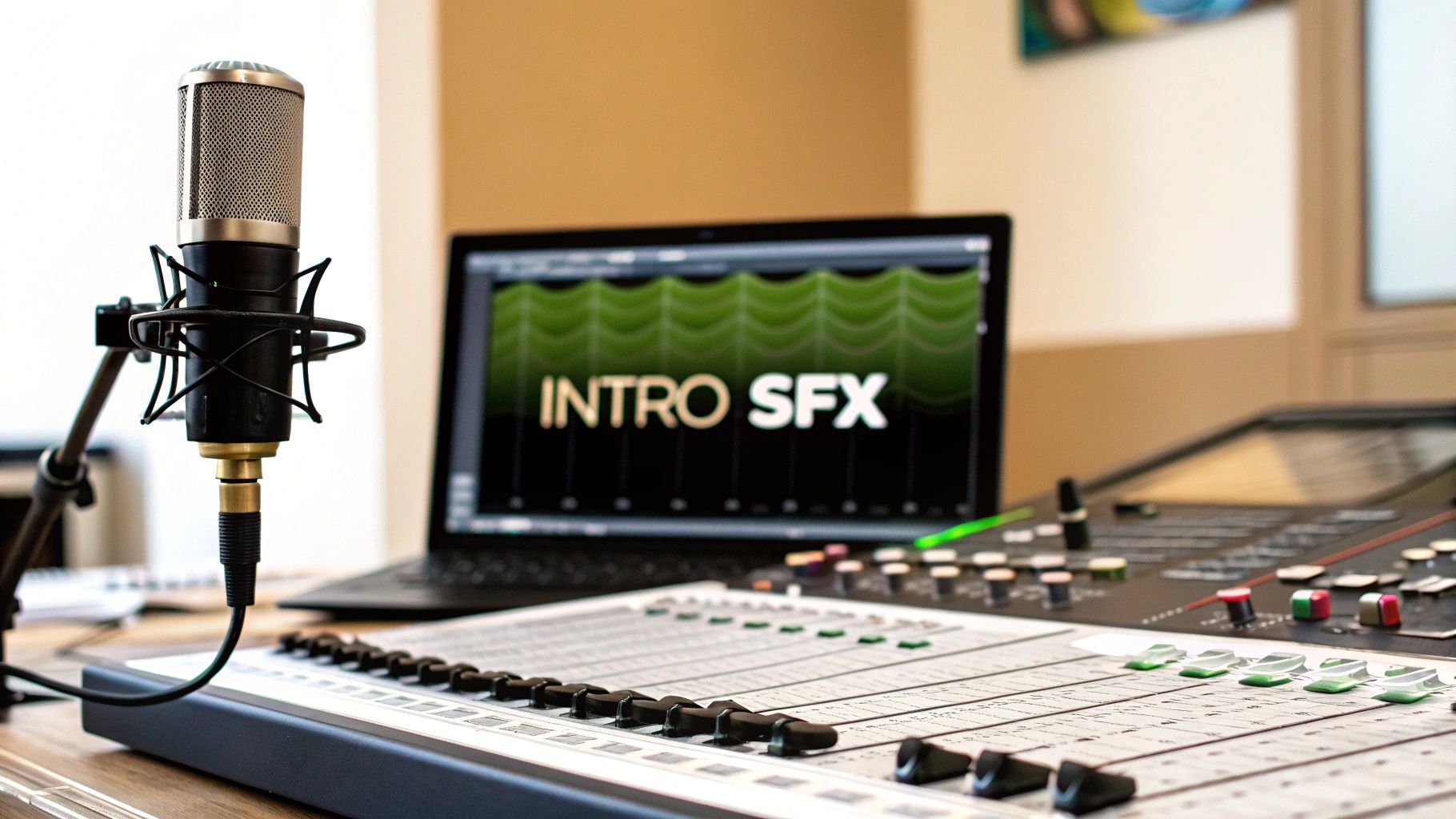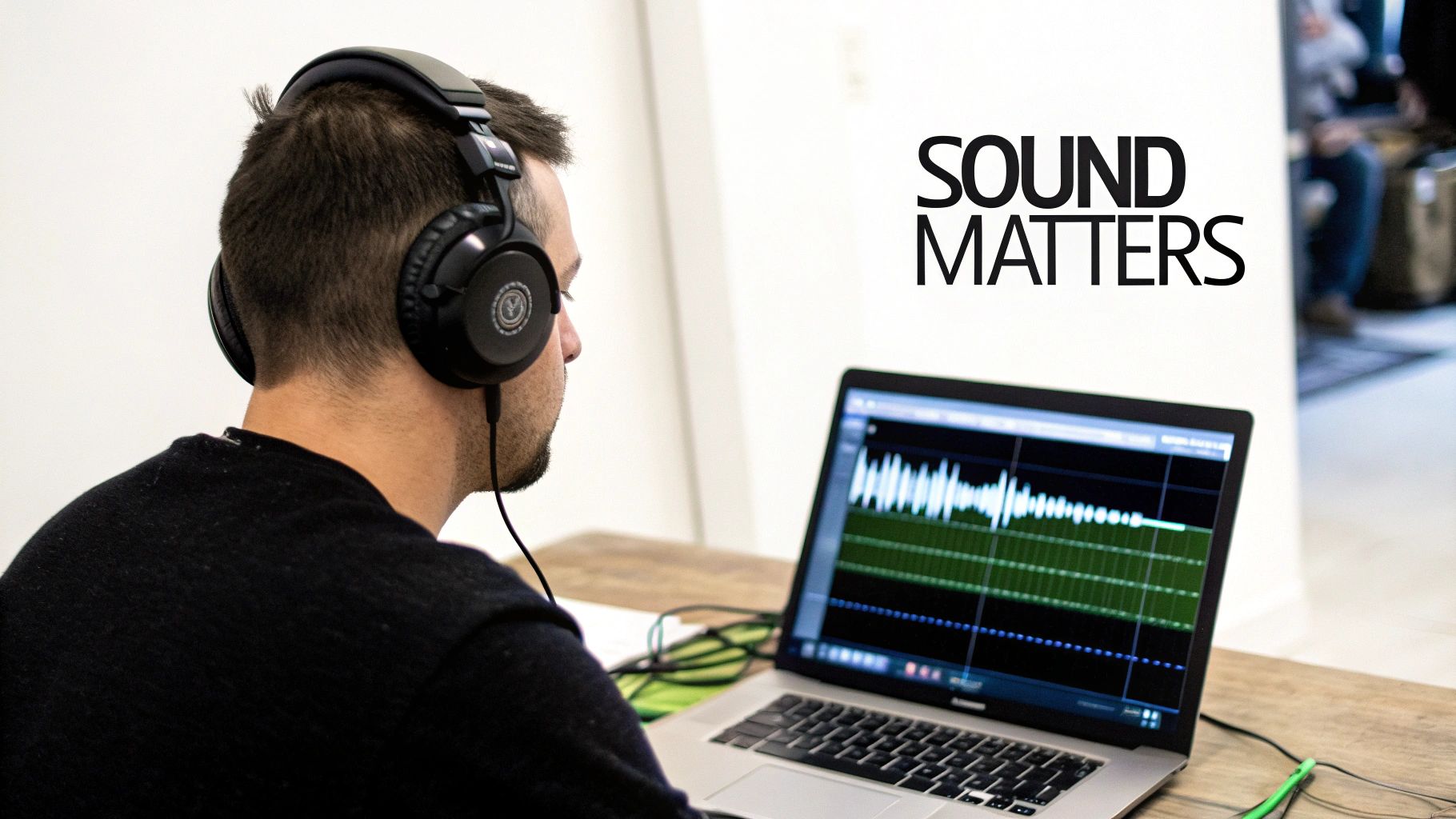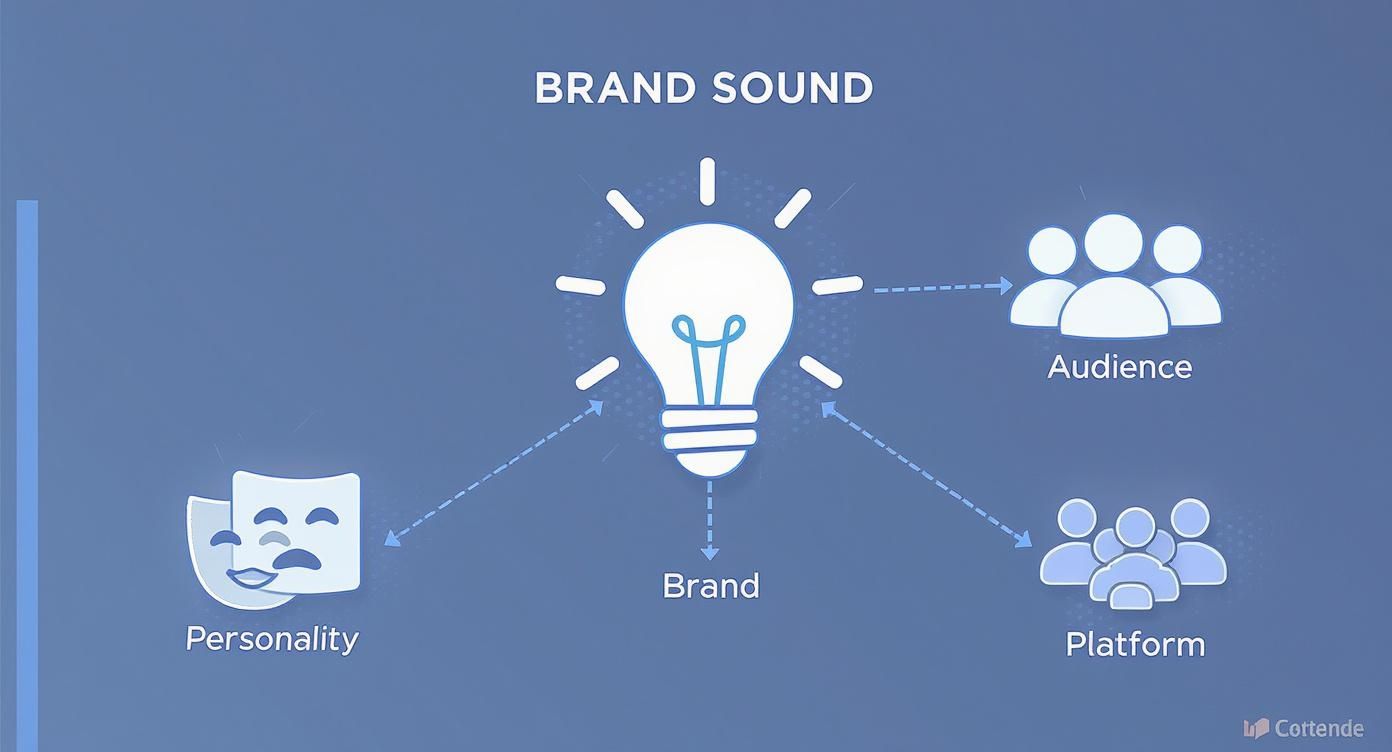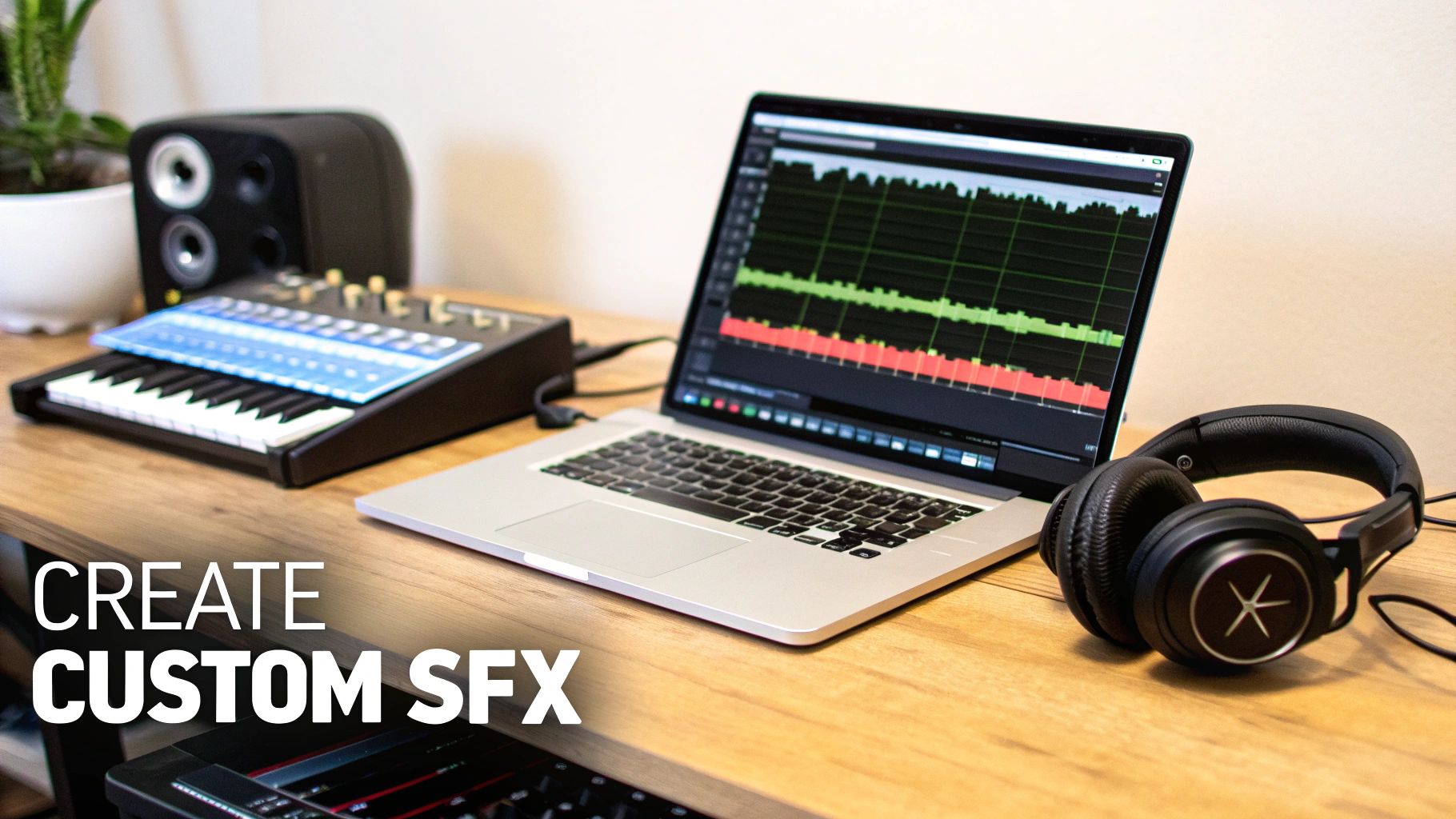
Sound effects for intros are those short, punchy audio clips you hear right at the beginning of a video or podcast. Think of things like whooshes, risers, or sharp little stingers that grab your attention. They're not just filler; these sounds are your opening act, responsible for setting the tone and making your content feel professional from the get-go.

Ever notice how the opening sound of a hit Netflix show or a blockbuster movie instantly gets you hyped? That’s not an accident. That brief audio cue is doing heavy lifting—it sets the mood, builds anticipation, and tells you exactly what kind of ride you’re in for.
Your intro's sound has the exact same job, but on a much tighter deadline. You have only a few seconds to make it count. This is about using audio as a strategic storytelling tool to forge an immediate, almost subconscious connection with your audience. The right sound effects for intros act as a powerful psychological trigger, assuring viewers they've come to the right place.
A well-chosen sound effect instantly injects a sense of professionalism and authority into your content. Imagine a tech channel using a crisp, clean swoosh as its logo animates on screen. It feels modern and efficient. On the flip side, a wellness podcast might use a gentle, resonant chime to create a feeling of calm and trust right away.
Poor audio, however, does the opposite. A generic or low-quality sound can make your entire production feel amateurish, tempting viewers to click away before you’ve even had a chance to deliver your message. This judgment happens in a flash and is tough to reverse.
Your intro sound is your digital handshake. It conveys confidence, personality, and professionalism—or a lack thereof—before you've said a single word. A weak handshake leaves a poor impression, and a weak audio intro does the same for your content.
The right sound doesn't just catch the ear; it frames the entire experience. This table breaks down how different audio choices can immediately shape what your audience thinks and feels.
| Audio Characteristic | Positive Impact (Professional SFX) | Negative Impact (Poor SFX) |
|---|---|---|
| Clarity & Quality | Projects professionalism and high production value. | Suggests amateur content and lack of effort. |
| Tone & Mood | Aligns with content, building immediate trust and anticipation. | Creates a disconnect, confusing or putting off the audience. |
| Originality | Makes the brand memorable and unique. | Fades into the background with generic, overused sounds. |
| Pacing & Energy | Grabs attention and sets an engaging rhythm for the video. | Feels jarring, slow, or mismatched with the visual pace. |
As you can see, the difference is stark. Investing in the right sound is a direct investment in how your audience perceives your brand from the very first second.
This all ties back to the core concept of audio branding—using a consistent, signature sound to make your brand instantly recognizable. This isn't some new-age marketing trick; sound has been defining media for over a century. By the 1950s, television was already using clever audio cues to hook audiences from the first frame.
In fact, some research suggests a well-crafted intro can boost brand recall by as much as 30%, showing just how valuable it is. The goal is to create an audio signature that works hand-in-hand with your visuals.
To see how this fits into the bigger picture of creating engaging content, it’s worth exploring the principles of mastering social video production. At the end of the day, your intro's sound effect isn't just an add-on; it’s a fundamental piece of your brand’s first—and most critical—impression.
Choosing the right sound effects for intros isn't about just grabbing a cool noise you like. Think of it more like casting the lead role in your brand’s story. The sound you pick becomes your audio signature—it’s the theme song that tells your audience who you are before a single word is spoken.
We agonize over logo colors and font choices, and our intro sound deserves that same level of care. It has to be a deliberate reflection of your brand's identity.
Imagine a high-octane fitness channel kicking off with a soft, gentle chime. It just feels... off, right? It creates a confusing first impression that clashes with the visual energy. Now picture a tech review channel using a slick, futuristic whoosh. That sound instantly signals innovation and speed. Your goal is to create that perfect harmony between what your audience sees, feels, and hears.
It all starts with getting crystal clear on your brand's personality. Is your content serious and authoritative, or is it more playful and energetic? Are you trying to come across as calming and trustworthy, or are you the edgy disruptor in your niche? Every sound carries emotional weight, so picking the right one ensures your audio reinforces the exact personality you want to project.
To find that perfect sound, you first have to know what your brand stands for. This isn't some fluffy marketing exercise; it's the bedrock of your audio identity. Start by asking yourself a few pointed questions.
Getting a handle on the fundamentals of branding is a huge help here. If you need a refresher, this ultimate guide to startup branding is a fantastic resource. A solid brand strategy makes all your audio choices fall into place.
Once you've nailed down your brand's personality, you can start translating those ideas into actual audio characteristics. This is where you go from abstract concepts to concrete sound design. Let’s break down how different brand identities might translate into specific sound effects for intros.
1. The Modern Tech Brand This brand is all about innovation, efficiency, and a clean, minimalist vibe. Its sound should feel sleek and forward-thinking.
2. The Wellness and Lifestyle Brand Here, the focus is on calm, mindfulness, and authenticity. The sound needs to be gentle, organic, and reassuring.
3. The High-Energy Entertainment Brand This brand is bold, exciting, and built to grab your attention from the first second. The audio has to be dynamic and pack a punch.
The best intro sound doesn't just announce your content; it embodies it. A viewer should be able to close their eyes, hear that sound, and know instantly what your brand is all about. It’s an emotional and thematic shortcut.
This same thinking applies to even the tiniest audio cues. For a deeper dive into how short sounds work, you can learn more about creating effective https://sfxengine.com/blog/notification-sound-effects, as they share many of the same branding principles.
When you align your sound with your identity, you sidestep generic choices and forge an audio signature that’s both authentic and instantly recognizable. That kind of sonic consistency builds real brand equity over time, making your content memorable long after the intro is over.
Once you’ve figured out how your audio should align with your brand, it’s time to dive into the creative toolbox of sound effects for intros. We're going way beyond simple jingles here. This is about crafting an opening that isn't just heard, but felt. Think of each type of sound effect like a different camera shot in a film—each one serves a unique purpose.
Getting to know these categories gives you a practical language for finding or creating the perfect audio cue. Instead of just searching for "intro sounds," you can zero in on the exact sound you need to hit a specific emotional beat or tell a micro-story. This is the kind of deliberate thinking that separates amateur work from a truly polished production.
A whoosh is the sound of pure movement. It’s that satisfying zip you hear when an object flies past the screen, a logo animates into place, or the camera pans quickly. These sounds are all about energy, and they’re fantastic at grabbing the viewer’s eye and directing it to a specific action.
They add a layer of dynamic energy that visuals alone just can't match. A simple line of text appearing on screen feels so much more impactful when it’s paired with a sharp swoosh, making the whole intro feel faster and more exciting.
A riser is an audio cue that slowly builds in pitch and intensity, and it’s a master of creating tension. It's the sound equivalent of a slow zoom-in on a character's face just before a big reveal. When your audience hears a riser, they instinctively know something important is about to happen.
This makes them perfect for building a little drama before your main content kicks off. A well-timed riser can make even a simple logo reveal feel like a major cinematic event, guaranteeing you have your audience’s complete attention.
The infographic below shows how different factors—like your target audience and the platform you’re on—play a role in which sound effects will work best.

As you can see, your brand’s personality, your audience, and where you post your content are all connected. They should all guide your decisions when picking sounds.
A stinger is a short, punchy sound effect—often with a melodic touch—that’s designed to punctuate a key moment. Most of the time, this is the final logo reveal. It’s basically an audio exclamation point, leaving a memorable and definitive stamp at the end of your intro. A great stinger is your brand’s sonic signature.
A stinger is your audio logo. It’s that final, memorable sound that should echo in a viewer’s mind, making your brand instantly recognizable the next time they hear it.
Big-time film studios and TV networks use stingers to create a powerful sense of brand authority. Just think of the iconic Netflix "ta-dum" sound—that’s a world-class stinger doing its job perfectly.
Finally, we have ambient textures. These are the subtle background sounds that work behind the scenes to establish a mood or atmosphere. Unlike the other SFX, they aren't meant to be front and center. Their job is to create an immersive world, whether that's the low hum of a spaceship, the gentle rustle of leaves in a forest, or a gritty industrial drone.
Layering a subtle ambient texture underneath your other sound effects can add incredible depth. The demand for this kind of detailed audio has skyrocketed, and it’s no surprise why. The sound effects services market was valued at USD 2.5 billion in 2023 and is expected to climb to nearly USD 4.8 billion by 2032, all because streaming, gaming, and other media need more immersive audio.
If you’re aiming for a grander, more atmospheric vibe, our guide on cinematic sound effects is a great place to find inspiration. By mixing and matching these different types of sound effects for intros, you can build a rich, layered audio experience that hooks your audience from the very first second.

Why spend hours sifting through stock audio libraries for the "perfect" intro sound when you can design it yourself? Let's be honest, the ideal audio signature for your brand probably doesn't exist yet. The good news is, you can bring it to life with the right tools. It's time to stop compromising and start building an audio identity that’s perfectly in sync with your vision.
Creating custom sound effects for intros isn't some dark art reserved for seasoned audio engineers anymore. With AI-powered tools like SFX Engine, you can become the architect of your own soundscape. The entire process is about layering simple ideas to build something truly unique and memorable.
This is your chance to ditch the generic sound packs and craft an intro that is authentically yours, ensuring your audio is as original as your content.
Think of creating a sound effect like cooking. You don't just throw everything in a pot at once. You start with individual ingredients and combine them thoughtfully to create a final dish. In sound design, those ingredients are different types of audio elements. The real magic happens when you layer them.
Here are the fundamental layers you can start mixing and matching:
By blending these layers, you can build a sound that tells a micro-story in just a few seconds. For instance, a tech channel might layer a quick whoosh with a subtle digital glitch and end with a sharp click—creating a sound that feels modern and precise.
Your goal isn't just to make noise; it's to create an experience. Layering sounds allows you to craft a cohesive audio narrative that captures your brand’s essence, turning a simple intro into a powerful statement.
With a tool like SFX Engine, this process becomes surprisingly straightforward. You don't need a degree in audio engineering; you just need a clear idea of what you're trying to achieve.
Here’s how you can approach it:
Start with a Clear Prompt: Begin by describing the core sound you're imagining. Don't just type "intro sound." Get more descriptive. Try something like, "A fast whoosh sound followed by a deep, cinematic bass drop with a slight echo." The more detail you give the AI, the better your starting point will be.
Generate and Refine: The AI will create a sound based on your prompt. Now, listen closely. Does it have the right energy? Is the timing right? The first result is rarely perfect, but it’s a fantastic creative launchpad.
Adjust the Key Parameters: This is where you really start to dial it in, fine-tuning the sound to match your video's pacing and brand's vibe. Focus on a few key adjustments:
Layer and Export: Once you have a few elements you like—a whoosh, a bass drop, a textural glitch—you can export them as separate files. Then, simply layer them together in your video editing software. This gives you the ultimate control over the final timing and volume of each component.
If you want to dive deeper into this creative process, our detailed guide on how to create sounds from scratch offers even more techniques and insights. Making your own sound effects for intros gives you an incredible level of creative freedom, transforming your intro from a simple placeholder into a powerful and unforgettable piece of your brand's identity.
There's nothing more frustrating than crafting the perfect intro only to have it completely sabotaged by a simple audio mistake. A poorly chosen or badly implemented sound effect can instantly cheapen even the most polished visuals. To make sure your intro actually enhances your content instead of dragging it down, you need to sidestep a few common pitfalls.
Honestly, most creators fall into the same handful of traps. These errors might seem small, but they have a huge impact on a viewer's first impression. A great intro sound should feel so natural you barely notice it, but a bad one? It sticks out like a sore thumb.
Let's break down the most frequent blunders and, more importantly, how you can fix them to keep your intros sounding professional and compelling every single time.
Want to signal "amateur hour" in two seconds flat? Use a low-quality audio file. You could have a stunning 4K video, but if your intro sound is a crunchy, compressed MP3, the whole production just feels cheap. Low-bitrate audio is notorious for weird artifacts—that fuzzy, tinny, or watery sound that’s just plain jarring to listen to.
We’ve all been there. You click on a video, and your speakers (or headphones) are immediately assaulted by an intro that’s twice as loud as everything else. It’s an instant turn-off. This usually happens when a creator just drops a sound effect into their timeline without bothering to mix it properly. An intro sound should grab attention, not cause physical pain.
Listener behavior studies consistently show that jarring audio is a top reason people click away from a video early. Consistent audio levels are non-negotiable for a good viewing experience.
Your intro sound should be a confident greeting, not an aggressive shout. The goal is to welcome your audience, not startle them into lunging for the volume knob—or worse, the back button.
The fix is simple: balance your audio levels. Your intro SFX can be a little louder than any background music, but it should never, ever overpower your voice or the main content that comes right after. You're aiming for a smooth, seamless transition in volume.
This one is subtle but powerful. It’s when the sound completely clashes with the video's tone or visual style. Picture a serene, minimalist video about meditation that opens with a loud, aggressive bass drop. The disconnect is confusing and immediately shatters any sense of immersion you were trying to build.
This happens when a sound is picked in isolation, without thinking about the whole package. Your audio and your visuals have to be on the same team, telling the same story.
To make this even clearer, here's a quick checklist to help you spot and solve these common problems before they go live. Think of it as your go-to guide for a quick audio check-up.
| Common Mistake | Why It's a Problem | How to Fix It |
|---|---|---|
| Using Low-Quality Audio | Makes your entire production feel unprofessional and cheap. It's distracting and sounds awful. | Source files from professional libraries. Use uncompressed formats (WAV) or high-bitrate (320kbps MP3) files. |
| Volume Is Way Too Loud | Startles and annoys viewers, often causing them to immediately click away or mute the video. | Mix your audio properly. The intro SFX should be present but not overpowering. Aim for a smooth volume transition into your main content. |
| The Sound Doesn't Match the Vibe | Creates a confusing or jarring experience for the viewer and undermines the video's intended mood. | Align the sound with your brand and the video's tone. Preview the SFX with your visuals to ensure they complement each other. |
By dodging these simple yet critical mistakes, you can be confident that your intro sound is doing its job perfectly—hooking your audience and setting the stage for the awesome content you've created.
Getting a handle on sound effects for intros isn't just about keeping up with today's trends—it’s about preparing for what’s next in digital media. The way we consume audio is changing fast, moving away from basic stereo and into a world of dynamic, interactive sound that will completely reshape how we connect with audiences.
Audio is no longer just background noise; it’s becoming the environment itself. We're stepping into a new era where sound isn't just heard, it's felt, forging a much deeper, more memorable bond between your content and your audience.
One of the biggest waves hitting the shore is the shift to immersive audio. Think of tech like spatial audio and 3D audio, which are quickly breaking out of high-end cinemas and niche VR experiences and into our everyday devices. These formats build a true soundscape where audio seems to come from all directions—above, below, and all around you.
Picture an intro where a whoosh doesn't just travel from left to right in your headphones. Instead, it feels like it’s actually flying right past your head. This technology injects a serious dose of realism and excitement, making those first few seconds more gripping than ever. As AR and VR become more mainstream, creators who know how to design sound for these three-dimensional spaces will have a massive edge.
The future of audio isn’t about just listening; it’s about being present within the sound itself. As technology makes this more accessible, the quality of your sound design will directly impact how deeply your audience connects with your content.
The other game-changer on the horizon is artificial intelligence. AI isn't just a tool for creating sound effects anymore; it's starting to craft adaptive audio that can react and change in real-time based on how a user interacts with the content or their environment.
This unlocks some wild possibilities for personalizing the user experience. Imagine an intro whose sonic intensity subtly adjusts based on the time of day someone is watching. It's no wonder the demand for software capable of this level of audio sophistication is exploding.
The global market for sound effects software was valued at around USD 3.5 billion in 2024. Forecasters expect it to climb to USD 7.1 billion by 2033, a surge driven by the hunger for next-level audio across every corner of digital media. If you're curious, you can explore more about this market growth and what's behind it.
Keeping an eye on these trends puts you ahead of the curve. The skills you're developing right now—choosing and crafting powerful sound effects for intros—are the exact skills you'll need to create the next generation of digital content.
Getting the audio just right can feel tricky, and it's normal to have a few questions as you dial in the perfect intro for your content. Let's tackle some of the most common ones that creators run into.
Think of this as the final checklist to make sure you can move forward with confidence and create an intro that truly works.
The magic number is between 2 and 5 seconds. That’s the sweet spot. It gives you just enough time to capture attention and set a vibe without making your audience wait for the main event.
Go any shorter, and it might just fly by unnoticed. Go longer, and you risk losing people before you’ve even started. In fact, podcasting data shows a listener drop-off of about 20-35% in the first few minutes. A short, punchy intro respects your audience’s time and pulls them into your content immediately.
Your intro sound should be a quick, memorable handshake, not a long monologue. It's there to hook your listener and then gracefully step aside for the real show.
You absolutely can, and you probably should! Layering different sounds is what separates amateur audio from a professional, polished intro. It's how you build a unique audio signature that feels custom-made for your brand.
A simple but incredibly effective approach is to combine a few distinct elements to create a tiny audio story.
When you start layering sounds like this, you're not just finding audio—you're designing it.
Finding great audio without legal headaches is much easier than it used to be. For massive, well-organized libraries, you can’t go wrong with platforms like Epidemic Sound or Artlist. They run on a subscription basis and give you a huge catalog of professional-grade sounds to choose from.
The other route, which gives you ultimate creative control, is using a generative AI tool like SFX Engine. Instead of digging through a library hoping to find the right sound, you just describe what you want, and the AI creates it for you from scratch. This guarantees your intro sound is 100% unique and royalty-free.
Ready to stop searching and start creating? With SFX Engine, you can generate the perfect custom, royalty-free intro sound in seconds. Design an audio signature that’s as unique as your content. Try SFX Engine for free and make your brand unforgettable.